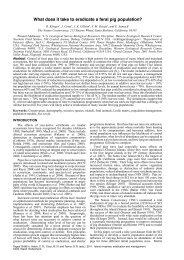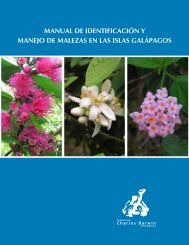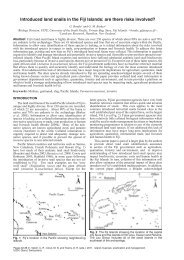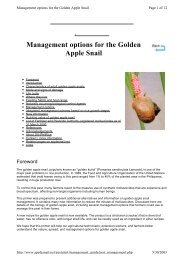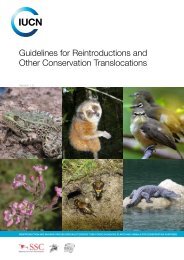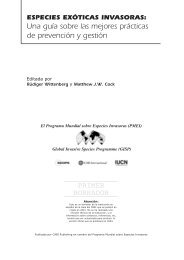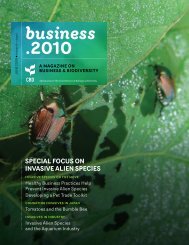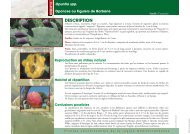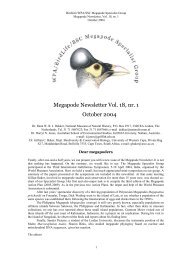Aliens Newsletter - ISSG
Aliens Newsletter - ISSG
Aliens Newsletter - ISSG
Create successful ePaper yourself
Turn your PDF publications into a flip-book with our unique Google optimized e-Paper software.
2008). “However, neither campaign was effective<br />
in controlling beavers or in stopping their spread”<br />
(Parkes et al. 2008). Similarly, governmental environmental<br />
agencies of both countries, aware of the<br />
seriousness of the problem, followed the issue in national<br />
and bi-national forums in order to install the<br />
problem as a priority.<br />
Figure 5: Beaver trapped in Brunswick Peninsula. Photo:<br />
SAG (Agricultural and Livestock Service Chile)<br />
After 20 years some conclusions arose in the<br />
Chilean and Argentinean management experience,<br />
including: 1) in the light of international eradication<br />
experience, commercial use alone can not solve the<br />
invasion problem; 2) beaver ecology (i.e. conspicuous<br />
presence derived from dam construction, distribution<br />
restricted to riverine environments, relatively<br />
slow population growth rate) makes beaver<br />
removal something achievable; and 3) beaver invasion<br />
represents a continental threat for the South<br />
American continent. All these conclusions led to a<br />
drastic strategy change which included the development<br />
of a new management model for this invasive<br />
species. From here, representatives of all national<br />
and regional environmental agencies of<br />
Chile and Argentina, along with NGO’s, started<br />
walking a non-travelled path in order to develop a<br />
bi-national strategy for the eradication of beavers in<br />
their entire range of distribution (Rio Gallegos, August<br />
2006). By that time, a first bi-national committee<br />
was created to implement a first agreement for<br />
beaver eradication that was further established as the<br />
formal bi-national Agreement mentioned above.<br />
This was also the result of actions implemented by<br />
the environmental agencies of both countries in order<br />
to promote the idea of eradication as a priority<br />
in both National and Bi-national fora, with the ul-<br />
timate goal of giving a final solution to an old problem.<br />
This constitutes a real and significant innovation,<br />
considering the complexity and size of the<br />
beaver problem that would induce a “sort of fatalism”,<br />
as Simberloff says (2002).<br />
Shift in strategy, a new vision and a Feasibility<br />
Study<br />
The new vision built to guide beaver management<br />
is to recover ecosystems of the southern end of<br />
South America, with two associated objectives:<br />
1. To eradicate beavers from its current range of distribution<br />
in the southern end of South America.<br />
2. To recover and/or restore the environments affected<br />
by beaver.<br />
In addition to boosting the recovery of important<br />
ecosystems and the ability to provide environmental<br />
and economic services for the local and international<br />
community, the beaver eradication project expects<br />
to develop a new model for handling complex<br />
environmental problems. This new model should be<br />
based in bi-national, public/private integration, incorporation<br />
of international expertise, and in the development<br />
of scientific, technical, administrative,<br />
and institutional capacities applied for dealing with<br />
regional conservation problems.<br />
The first step implemented under this new vision<br />
was the development of a Feasibility Study for<br />
beaver eradication, which congregated authoritative<br />
and independent expertise in eradication (2007-<br />
2008). This study, approved by both countries, summarizes<br />
beaver ecology, beavers ecological and economic<br />
impacts, beaver management, control techniques,<br />
social and political context, and discuss pros<br />
and cons of alternative management options (Parkes<br />
et al. 2008).<br />
The beaver Feasibility Study concluded that eradicating<br />
beavers from their entire distribution in<br />
Patagonia and Tierra del Fuego is justified and feasible.<br />
Moreover, it indicated that technical, ecological,<br />
cultural, and social standpoints are available to<br />
ensure complete removal at all management units,<br />
all legal tools provided. This study also indicated<br />
that an effective and efficient bi-national management<br />
structure is required to commit cooperation of<br />
funding agencies. The study also pointed out main<br />
risks of failure, like the ability to access beavers on<br />
lands of all tenures, or the possibility of scaling eradication<br />
from the colony to the landscape level, must<br />
be resolved before any eradication is attempted.<br />
Other risks, such as the ability to manage reinvasions,<br />
will have to be tested as operations proceed<br />
(Parkes et al. 2008). The Feasibility Study also in-<br />
<strong>Aliens</strong> 13



